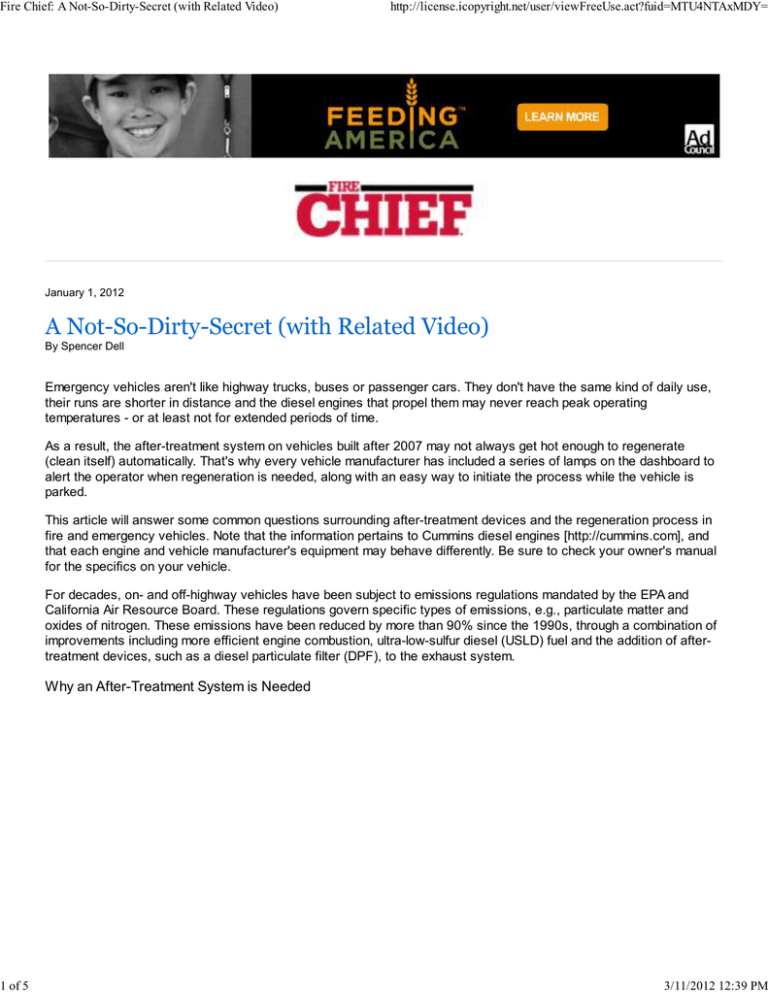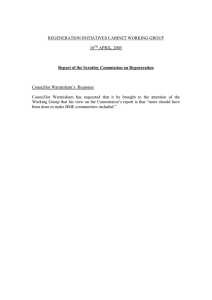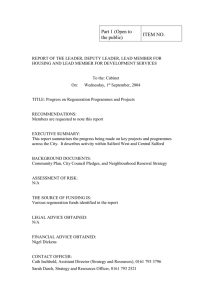
Fire Chief: A Not-So-Dirty-Secret (with Related Video)
1 of 5
http://license.icopyright.net/user/viewFreeUse.act?fuid=MTU4NTAxMDY=
January 1, 2012
A Not-So-Dirty-Secret (with Related Video)
By Spencer Dell
Emergency vehicles aren't like highway trucks, buses or passenger cars. They don't have the same kind of daily use,
their runs are shorter in distance and the diesel engines that propel them may never reach peak operating
temperatures - or at least not for extended periods of time.
As a result, the after-treatment system on vehicles built after 2007 may not always get hot enough to regenerate
(clean itself) automatically. That's why every vehicle manufacturer has included a series of lamps on the dashboard to
alert the operator when regeneration is needed, along with an easy way to initiate the process while the vehicle is
parked.
This article will answer some common questions surrounding after-treatment devices and the regeneration process in
fire and emergency vehicles. Note that the information pertains to Cummins diesel engines [http://cummins.com], and
that each engine and vehicle manufacturer's equipment may behave differently. Be sure to check your owner's manual
for the specifics on your vehicle.
For decades, on- and off-highway vehicles have been subject to emissions regulations mandated by the EPA and
California Air Resource Board. These regulations govern specific types of emissions, e.g., particulate matter and
oxides of nitrogen. These emissions have been reduced by more than 90% since the 1990s, through a combination of
improvements including more efficient engine combustion, ultra-low-sulfur diesel (USLD) fuel and the addition of aftertreatment devices, such as a diesel particulate filter (DPF), to the exhaust system.
Why an After-Treatment System is Needed
3/11/2012 12:39 PM
Fire Chief: A Not-So-Dirty-Secret (with Related Video)
2 of 5
http://license.icopyright.net/user/viewFreeUse.act?fuid=MTU4NTAxMDY=
Today's emergency vehicles run at near-zero emissions levels, demonstrating a commitment to the environment while
keeping communities safe by protecting people and property.
Vehicles with diesel engines manufactured after 2007 have an after-treatment system that includes a DPF that traps
and oxidizes soot particles. Soot consists primarily of unburned fuel. The after-treatment system consists of two parts:
the diesel oxidation catalyst (DOC) and a wall-flow filter typically called a DPF. Hot exhaust gases pass over the DOC
creating a catalytic reaction that transforms any hydrocarbons to harmless carbon dioxide and water vapor. If the
catalytic material isn't hot enough, the particles are trapped in the wall-flow filter until a regeneration occurs (either
active or passive), raising the temperatures high enough to oxidize the soot particles.
In addition to the DPF, selective catalytic reduction (SCR) technology can be used along with the existing aftertreatment system. Such technology uses diesel exhaust fluid to convert nitrogen oxide into harmless nitrogen, oxygen
and water vapor.
The following are important questions regarding after-treatment systems that should be considered.
What is DPF regeneration? Exhaust soot particles coming out of the engine are trapped in the DPF. If nothing is
done, these particles eventually will accumulate and clog the filter, restricting the exhaust flow. Regeneration is a
process much like cleaning an oven: The temperature is raised high enough so that the carbon in the soot is oxidized,
leaving just trace amounts of ash.
DPFs come with a pressure sensor that measures the amount of air flowing through the system, so that the electronic
control module (ECM) receives a signal when the filter needs regeneration and automatically starts the process. This
is called "passive" regeneration, because it happens during the normal operation of your emergency vehicle, has no
effect on engine performance and won't even be noticed by the driver.
What should drivers be looking for? There are two lamps on the vehicle instrument panel that firefighters will notice
when the vehicle is first turned on: the DPF lamp and the high exhaust system temperature (HEST) lamp.
The DPF lamp illuminates when the filter starts to get full. This tells the driver that regeneration is needed by taking the
vehicle for a 20- to 30-minute run at highway speeds.
If the DPF lamp starts flashing, it's a sign that regeneration needs to be performed soon. It doesn't matter whether this
is achieved by driving on the road or during a "parked" or "stationary" regeneration, as long as the process occurs to
oxidize the soot.
When the HEST lamp illuminates, it simply reminds the driver that regeneration is taking place and that exhaust
temperatures may be higher than normal. It's important to make sure nothing combustible is near the exhaust pipe.
There also is a DPF regeneration inhibit switch near the driver that allows the operator to prevent a regeneration from
starting or stop one in process. This only should be used when high exhaust temperatures might create a hazardous
condition. Unnecessary or excessive use of this switch will result in an increased need for parked regeneration, as the
DPF will continue to fill with soot. Regeneration cannot occur while in the inhibit mode.
3/11/2012 12:39 PM
Fire Chief: A Not-So-Dirty-Secret (with Related Video)
3 of 5
http://license.icopyright.net/user/viewFreeUse.act?fuid=MTU4NTAxMDY=
What happens if the engine exhaust doesn't get hot enough to clean the DPF? This is not an uncommon
scenario in emergency equipment. Eventually, the DPF will fill to the point where airflow is inhibited. At that point the
DPF lamp on the instrument panel will light up, indicating that the system needs regeneration soon. Again, regeneration
normally is achieved by running the vehicle for at least 20 to 30 minutes at highway speeds (this is called "passive"
regeneration) or by performing an "active" regeneration.
Active regeneration is a process where a small amount of diesel fuel is introduced into the exhaust stream. During this
process, a chemical reaction takes place, raising the temperature inside the DPF so that soot is fully oxidized and the
filter is cleaned. Even though it's called active regeneration, it is started automatically and controlled by the engine with
no need for any driver action. It does not affect engine or vehicle performance, and the only indication that
regeneration is taking place will be the illumination of the HEST lamp on the instrument panel. Once regeneration is
completed, and the exhaust system cools down, both lamps turn off.
Remember that if the vehicle is parked in a location with potential heat hazards, and you do not want an active
regeneration to take place - or you want to stop the regeneration in process - the regeneration inhibit switch can
override the regeneration command. The switch then has to be turned off in order for future DPF regenerations to take
place in a normal manner.
What does it mean when the DPF lamp illuminates? The lamp first illuminates in a steady state to indicate that the
filter is starting to fill with soot and needs regeneration. If regeneration does not take place and the soot load continues
to increase, the DPF lamp will start flashing.
What does it mean when the DPF lamp is flashing and the check engine light comes on? This warns the vehicle
operator that regeneration is needed immediately to prevent plugging of the DPF and potential damage to the aftertreatment system. Again, it doesn't matter whether this is achieved by driving on the road or in a "parked" or
"stationary" regeneration, as long as the process occurs to oxidize the soot.
Unlike commercial trucks and vans, there is no engine "derate" or "shutdown" on an emergency vehicle. Once the
emergency has been handled, fire truck operators should respond to the soot load indicators and ensure that passive
or active regeneration takes place as needed. If a DPF gets fully plugged, it will need to be removed from the aftertreatment system and cleaned or replaced.
3/11/2012 12:39 PM
Fire Chief: A Not-So-Dirty-Secret (with Related Video)
4 of 5
http://license.icopyright.net/user/viewFreeUse.act?fuid=MTU4NTAxMDY=
What does it mean when the stop engine lamp illuminates? This means that the DPF has plugged to the point that
it needs repair from an authorized repair location. This lamp will illuminate if regeneration was not performed when the
operator was notified of high soot levels via the flashing DPF lamp in conjunction with the warning or check engine
lamp. As soon as it is safe to do so, the vehicle should be stopped so this repair can take place. If the vehicle
continues to operate without timely repair, damage to the after-treatment system could result.
It is possible that the DPF will become plugged to the point where you may experience degradation in the engine's
performance. This potential power loss is not a de-rate generated by the engine's monitoring system, but instead is
similar to a passenger car's exhaust becoming plugged or blocked.
What is a "parked" or "stationary" regeneration? The alternative to taking an emergency vehicle out and running it
on the road is to perform a "parked" or "stationary" regeneration. This is the only driver-initiated interaction with the
system. Pushing the manual regeneration switch in the driver compartment while the vehicle is parked and idling will
cause the engine's RPMs to increase and will add a small amount of diesel fuel until operating temperatures are high
enough so that carbon in the filter is oxidized. This process takes approximately 40 minutes. The HEST light will come
on, indicating that the exhaust temperature is elevated, so the operator must take care that the exhaust system is not
near any combustible materials during this operation.
What if our vehicle is in the middle of parked regeneration and a call comes in? Just get in the vehicle and tap
the brake to interrupt the regeneration process, and you're ready to roll. Running your emergency vehicle will actually
help the cleaning process take place. If it's just a short run, you still may need to perform a parked regeneration
afterwards to complete the cleaning process.
Will regeneration take place during PTO operation or pumping? This is a feature programmed by each individual
vehicle original equipment manufacturer. Consult your owner's manual to see whether this feature is available on your
engine. If active regeneration is allowed, the HEST lamp will illuminate, indicating high exhaust system temperatures.
Power takeoff, or PTO, operation and pumping capabilities will not be affected, regardless of whether regeneration is
allowed. Simply press the regeneration inhibit switch to prevent active regeneration during PTO operation. And don't
forget to disengage the switch once the PTO operation has been completed and you no longer need to inhibit
regeneration.
What happens if the inhibit switch is left on and the DPF gets plugged? When the DPF starts to become full of
soot, a series of warning lamps will illuminate to indicate that regeneration needs to take place. Be sure to always
check and make sure that the regeneration inhibit switch is not engaged. This will prevent the after-treatment DPF from
performing regeneration and may be the root cause for the warning lamps. And be sure to monitor use of the inhibit
switch and pay attention to subsequent warning lamps that may indicate that the switch has been left on.
If regeneration oxidizes all the soot, why do the DPFs still need cleaning? In addition to hydrocarbons that come
out of the engine in the exhaust, there also are trace amounts of lubrication oil that contains additives, and a tiny
amount of sulfur (even from ULSD fuel). Because these elements don't oxidize, they eventually accumulate in the form
of ash and require cleaning from the filter. A typical DPF requires ash cleaning at approximately 300,000-mile or
6,750-hour intervals. A qualified service location can conduct this cleaning in just a few hours, so it can be scheduled
with routine maintenance.
Spencer Dell is with the engine-business marketing division of Cummins Inc.
Related Story:
Mutual Aid: More Harm Than Good? [http://blog.firechief.com/mutual_aid/2011/10/26/more-harm-than-good]
2012 Penton Media. Permission granted for up to 5 copies. All rights reserved.
You may forward this article or get additional permissions by typing http://license.icopyright.net/3.5474?icx_id=firechief.com
3/11/2012 12:39 PM
Fire Chief: A Not-So-Dirty-Secret (with Related Video)
5 of 5
http://license.icopyright.net/user/viewFreeUse.act?fuid=MTU4NTAxMDY=
/apparatus/how-cummins-engines-regenerate-201201/index.html into any web browser. Penton Media, Inc and Fire Chief logos are
registered trademarks of Penton Media, Inc . The iCopyright logo is a registered trademark of iCopyright, Inc.
3/11/2012 12:39 PM





